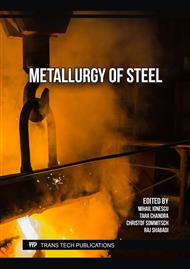p.105
p.111
p.117
p.123
p.129
p.135
p.141
p.147
p.153
Effects of Pre-Strain and Tempering on Mechanical Properties in High-Strength Martensitic Steels
Abstract:
Effects of pre-strain and tempering on mechanical properties in high-strength martensitic steels were investigated. In this study, strain tempering (ST) and quenching and tempering (QT) martensitic steels were prepared, and their mechanical properties were studied. In the tensile tests at the deformation temperatures between 296 and 573 K, the ST sample increased both of tensile strength (TS) and uniform elongation (U.El) from 473 to 523 K whereas the QT sample increased U.El with little change of TS. From the in situ neutron diffraction experiments, stress partitioning to the bcc phase increased with an increase in the deformation temperature from 296 to 523 K. The difference of phase stress between the bcc and cementite phases decreased with increasing the temperature because of a decrease in the cementite strength. In the ST sample, Pre-straining of 0.5% increased YS at 296 K with slight work hardening. The initial value of dislocation density (ρ) decreased at 523 K but ρ increased significantly after yielding, leading to better combination of TS and U.El. The combinations of pre-strain, tempering, and deformation temperatures have changed ρ before deformation and the increase of ρ after yielding of the martensitic steels.
Info:
Periodical:
Pages:
129-133
Citation:
Online since:
November 2023
Authors:
Price:
Сopyright:
© 2023 Trans Tech Publications Ltd. All Rights Reserved
Share:
Citation:



